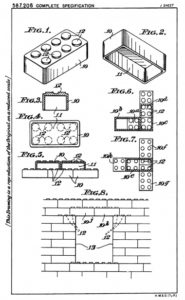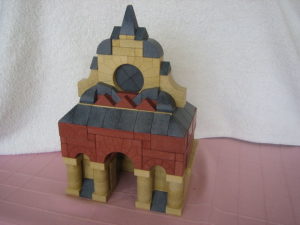How might the triumphal procession of the white coloured building block made of hard plastic have taken place? How could the grey ones conquer the world? It is a fact that in the UK, the psychologist and inventor Hilary (Harry) Fisher Page invented the first construction block between 1937 and 1940, and in 1940 he registered it's related patent. It is also a fact that from 1940 the UK had to deal with the problem of the Second World War so that further patents followed only in 1947, 1949 and 1952. In the chronicle of his company Kiddicraft, it says: Mr. "Page became deeply troubled with these pressures on the business and feared a total collapse of the company. Tragically, he committed suicide on June 24, 1957."
It may also be assumed that a now world-famous company adopted this interlocking concept and achieved far greater and long-term success with it. Their patent was filed in Copenhagen in 1958. It is also fairly certain that another company from the UK, founded in 1997 under the name Best-Lock, learned about Mr. Page's patents, which, after many court decisions, made it possible for them to establish themselves on the building block market, and nowadays even more companies. However, it must be admitted that since then the boundaries between the monopolist, which has been working in peace for many years, and the newcomers, which can no longer be bitten off, are still being defined in detail by the courts.

1944: Initial Hilary Page patent, earlier design (granted 1947)
The Long Timeline of Plagiarism
What always underlies all disputes is unauthorized copying. The word plagiarism is now on everyone's lips. Molds of terminal blocks are pirated, for example, but construction plans are also copied. There is patent protection for certain functions of clamp building blocks, i.e. not its shape, but its intended use. You will notice that sounds like a complex matter. On the positive side, so far no child has been convicted for using their own creativity to create something that has already been patented.
Of course, plagiarism is already an issue with the big competitors, especially since massive sums of money are involved. On the one hand, for example, a European manufacturer pays for the rights on Star Wars to the current copyright holder Disney, on the other hand, its own development costs and sales shortfall. There was a good example of a Chinese company dedicated to the Star Wars product series, where you can hardly distinguish what comes from which manufacturer, if not different logos and details in the outer packaging would allow conclusions. I don't think we need something like that in Europe, do we?

Anchor "stone palace"
The Roots of Stones
There are opinions that say that the inspiration of the clamping building blocks lies in the Anchor Stone Blocks, which have been produced again since 1995. The famous pedagogue Friedrich Fröbel provided children with geometric shapes through which they should develop their creativity. None others than the world-famous brothers Gustav and Otto Lilienthal invented and marketed the building blocks together with the construction kit in 1879. The building blocks hold themselves only due to their friction and gravity. Probably, like many other inventors, these brothers were ahead of their time. Due to lack of good marketing, they sold the idea to Friedrich Adolf Richter, who then patented it from 1882 and produced it in Thuringia with successful marketing. The production period of the Anchor Stone Blocks survived the two world wars until 1963. The today still expanding production counts as an award-winning educational toy.
At present, we tend to see the negative things that could have been done better in the age of industrialization that actually took place, from today's perspective. We have become accustomed to the inventions from that era in everyday life. But the negative was due to the existing system of the time.
Today, progress in technology also makes it possible to produce finer structures, so that, for example, models such as the BR 650 diesel powered railcar can be faithfully reproduced, even in the format of building blocks.

